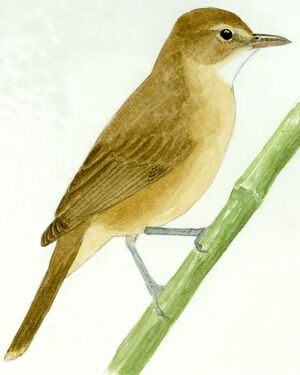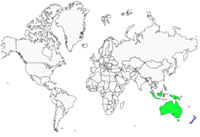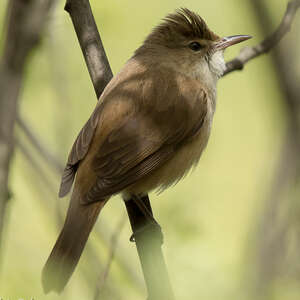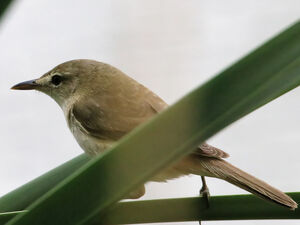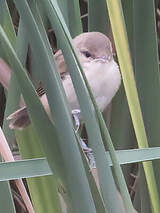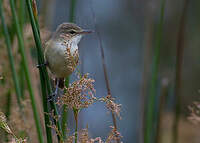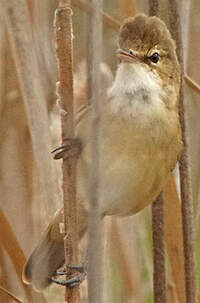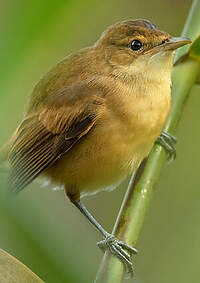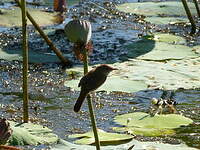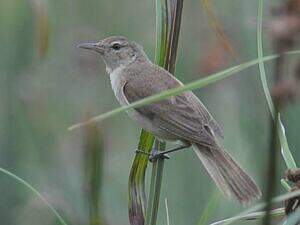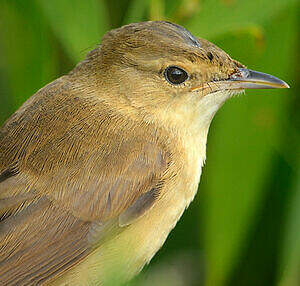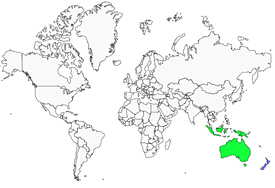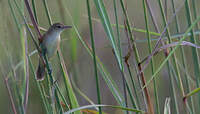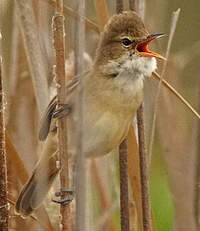Australian Reed Warbler
Acrocephalus australis - Rousserolle d'Australie
Identification
The Australian Reed Warbler, of medium size and short wings, is the secret bird of the reedbeds. It reminds us of the main Reed Warbler. Very discreet, it reveals its presence through its loud and melodious call. The colour of its plumage blends perfectly with its habitat. The male and female are similar. In fresh plumage, the upper plumage of the adult is brown tinged with ochre. The brown-grey cap can be raised in a crest. The nape is also greyer. A pale beige eyebrow extends from the beak to the back of the eye. The eye is surrounded by a cream orbital circle in two diffuse arcs, the upper one blending with the eyebrow. The iris is brown-beige. The beak, thin and long, is brown above and coloured yellow or pink at the lower mandible. A dark stripe marks the lores and continues to the back of the eye. The chin, throat and upper chest are whitish-cream while further down, the rusty shade intensifies from the lower chest to the undertail feathers of a bright red. The same phenomenon above with the rust intensifying from the back to the upper tail feathers. The upperwing coverts are also of a brownish-red intensifying from the scapulae to the great coverts. The remiges and retrices are of a very dark brown contrasting with the rest. The first ones are bordered with medium beige. The primary projection is low. The tarsus and fingers are almost black. The plumage lightens when worn. It is worn at the time of reproduction. The juvenile has a sustained and warm brown back, so it looks darker than the adult.
Subspecific information 3 subspecies
- Acrocephalus australis australis (e and se Australia)
- Acrocephalus australis sumbae (c and e Lesser Sundas, s Moluccas, New Guinea, Bismarck Arch. And Solomon Is.)
- Acrocephalus australis gouldi (w Australia)
Foreign names
- Rousserolle d'Australie,
- Carricero australiano,
- felosa-australiana,
- Australrohrsänger,
- ausztrál nádirigó,
- Australische Karekiet,
- Cannareccione australiano,
- australisk rörsångare,
- Australtrostesanger,
- trsteniarik hnedokrídly,
- rákosník australský,
- Australsk Drosselrørsanger,
- australianrastaskerttunen,
- boscarla d'Austràlia,
- trzciniak australijski,
- Австралийская камышевка,
- オーストラリアヨシキリ,
- 澳洲苇莺,
- 澳洲葦鶯,
Voice song and cries
The Australian Reed Warbler is known for its strong, rich, varied and melodious song that reveals its presence in the depths of reed beds. Its song is one of the most melodious in Australia. It's reminiscent of a nightingale's song. It is only heard during the breeding season. She sings continuously early in the morning. To know what it is, the best is to listen to it on xeno-canto https://xeno-canto.org/species/Acrocephalus-australis The call is a tjuk or a harsher tjruc very reed warbler-like. Normally, the Australian Reed Warbler is quite discreet, but you can still hear its calls in winter on sunny days.
Habitat
The presence of the Australian Reed Warbler is linked to a wide variety of wet habitats, but it prefers marshes, bogs, lake edges, springs, streams, dams and water treatment ponds as well as Pandanus parcels.
Behaviour character trait
The Australian Reed Warbler is a migratory species. Individuals from the south leave their breeding sites immediately after the nesting season, i.e.
from February to April. A small number are nevertheless recorded in wetland areas all year round. Wintering individuals in northeastern Queensland and the Northern Territory can arrive as early as December, it is then assumed to be failed nests as the majority of wintering birds arrive in April and leave in September-October to nest. Individuals present in mainland Australia are probably the most sedentary. The Australian Reed Warbler forages in dense vegetation habitats, reedbeds, trees and shrubs, and cropped areas. It can feed on the ground near the reedbeds, in muddy areas and on the edges of water points and/or in trees while hunting on the wing. Its territory is very well guarded through singing all day and until the night during full moon nights or very hot evenings. This surveillance remains focused on the immediate nesting area. The pair is monogamous; even partially polygamous and become very aggressive when it comes to defending the nest.Dietfeeding habits
Reproduction nesting
The nesting period has mostly been studied in Australia. It is still not very well known in the rest of the species' range but it seems that in Papua New Guinea and the Solomon Islands, birds may reproduce throughout the year. On the Australian continent, nesting begins in September and ends in February, regardless of the area, with a peak in December. The chosen site is within dense aquatic vegetation. These are reedbeds including phragmites, Baumes and scirpes. It may occasionally be the riparian bushes and shrubs near water points or the surrounding shrubs and bushes. These sites will be chosen by young couples who, arriving late to the area, have no other choice than to move away from the water points. The nest is attached 10 to 250 cm above the water with an average of 80 cm. The chosen materials are collected nearby and the nest is built by both sexes, although the female is more active than the male. The nest, deep, forming a cup, is woven with reeds, feathers, rootlets and fine grasses. It is lined with feathers, mostly black swan feathers. It is tightly bound to 4 or 5 vegetable rods, 8 maximum. Very resistant, the nest can be used for several years and the pair, faithful, often returns to its territory already occupied in the past.
Two to four days after the construction of the nest, the female lays 3 eggs over several days, sometimes 2 and a maximum of 4. They are speckled, pale blue, greenish, whitish gray or pale brown-yellow. She incubates alone between 11 and 16 days from the end of the laying or from the first egg between 15 and 16 days. Incubation mostly takes place at night, the male not feeding the female during the day, so she has to leave the nest to feed herself.The male then joins the female to feed the chicks but the behaviour of the two sexes is different. The male can travel up to 240 metres from the nest to hunt while the female will not leave the reed bed. The young are fed insects and their larvae. In case of bigger captures, the prey is cut up or immersed in water for a moment. Nestlings, the young take flight around the eleventh day and some are still fed up to the 29th day. It happens that the couple does a second nest, this one occurs 14 days after the first one flew away. In this case, a second nest is built above the first one. The same goes for replacement nests, the construction of the nest is then very quick, less than 4 days. The Australian Reed Warbler is parasitized by four species of cuckoo: the Pale Cuckoo, Fan-tailed Cuckoo, Horsfield's Cuckoo and Shining Cuckoo. However, the incidence of parasitism is relatively low and the cause of mortality is quite different. The causes of nest failure are mainly linked to predation from rats and snakes on the eggs as well as meteorological conditions. Heavy rains and, conversely, droughts can lead to the destruction of nests. The rate of flight of the young is equivalent to 1.39 young per nest.Geographic range
The Australian Reed Warbler lives and reproduces in Australia, where it is found in every state with a significant abundance in the east (Acrocephalus australis australis). Its population is smaller in Western Australia, where it is found mostly near the coast (Acrocephalus australis gouldi). Populations can also be found in Papua New Guinea, the Solomon Islands, and some Indonesian islands (Acrocephalus australis sumbae).
Threats - protection
IUCN conservation status
concern
in the Wild
threatened
evaluated
The Australian Reed Warbler is not threatened globally. It is locally abundant with high reproductive density throughout its range. Finally, the creation of artificial wetlands, waterways, irrigated agricultural lands and dams by humans compensates for the loss of its natural habitat due to burning, drainage and deforestation.
Sources of information
- IOC World Bird List (v14.1), Gill, F and D Donsker (Eds). 2024-04-18.
- eBird, Cornell Lab of Ornithology et National Audubon Society
- Birds of the World, The Cornell Lab of Ornithology
- Birds of Australia, Peter Rowland
Other sources of interest
 Specification sheet created on
17/07/2023 by Nathalie Santa Maria
Specification sheet created on
17/07/2023 by Nathalie Santa MariaTranslation by AI Oiseaux.net
published: 16-01-2023 - Updated: 19-01-2023
© 1996-2024 Oiseaux.net
- Accipitriformes
- Aegotheliformes
- Anseriformes
- Apodiformes
- Apterygiformes
- Bucerotiformes
- Caprimulgiformes
- Cariamiformes
- Casuariiformes
- Charadriiformes
- Ciconiiformes
- Coliiformes
- Columbiformes
- Coraciiformes
- Cuculiformes
- Eurypygiformes
- Falconiformes
- Galliformes
- Gaviiformes
- Gruiformes
- Leptosomiformes
- Mesitornithiformes
- Musophagiformes
- Nyctibiiformes
- Opisthocomiformes
- Otidiformes
- Passeriformes
- Pelecaniformes
- Phaethontiformes
- Phoenicopteriformes
- Piciformes
- Podargiformes
- Podicipediformes
- Procellariiformes
- Psittaciformes
- Pterocliformes
- Rheiformes
- Sphenisciformes
- Steatornithiformes
- Strigiformes
- Struthioniformes
- Suliformes
- Tinamiformes
- Trogoniformes

